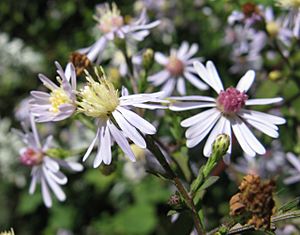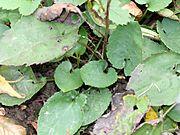Symphyotrichum cordifolium facts for kids
Quick facts for kids Symphyotrichum cordifolium |
|
|---|---|
 |
|
| Heartleaf aster | |
| Conservation status | |
| Scientific classification | |
| Genus: |
Symphyotrichum
|
| Species: |
cordifolium
|
| Synonyms | |
|
|
The Heartleaf Aster, also known as the Common Blue Wood Aster or Blue Wood-Aster, is a beautiful plant found in eastern North America. Its scientific name is Symphyotrichum cordifolium. This plant is a herbaceous perennial, which means it has soft stems (not woody like a tree) and lives for more than two years, coming back each growing season. It belongs to the Asteraceae family, which is the same family as sunflowers and daisies.
Contents
About the Heartleaf Aster
The Heartleaf Aster can grow quite tall, reaching up to about 1.2 meters (nearly 4 feet). Its lower leaves are shaped like a heart, which is how it got its common name. The leaves higher up on the stem are different; they sit directly on the stem without a stalk and have rounder bases.
The plant's flowers are actually made up of many tiny flowers grouped together. These flowers have bluish, or sometimes white, outer petals (called ray florets) and light yellow centers (called disc florets). The yellow centers eventually turn purple. You can see these lovely flowers blooming from August all the way into October.
Sometimes, the Heartleaf Aster can mix with another plant called Symphyotrichum puniceum. When they do, they create a new kind of plant called a hybrid, which is named Symphyotrichum × tardiflorum.
Where the Heartleaf Aster Grows
You can find the Heartleaf Aster across a large part of North America. It grows from Manitoba in Canada, east to Nova Scotia and Maine, and then south through Georgia and Alabama, and west to Oklahoma in the United States.
This plant likes places that are moderately moist, with soil that can be rocky or loamy (a mix of sand, silt, and clay). It prefers rich soil. You can find it from sea level up to about 1,200 meters (nearly 4,000 feet) high in the Appalachian Mountains. It often grows on open, wooded slopes, along stream banks, on moist ledges, and in swampy woods. It also likes the edges of forests, clearings, thickets, and even along roadsides and ditches. Sometimes, it can even pop up in cities!
Uses of the Heartleaf Aster
Traditional Uses
The Ojibwe people, a Native American tribe, traditionally used the Heartleaf Aster in a special way. They would burn parts of the plant to create an incense. This incense was believed to help attract deer.
Growing in Gardens
The Heartleaf Aster is a popular choice for gardens because of its beautiful flowers. Gardeners grow it under its current scientific name, Symphyotrichum cordifolium, and its older name, Aster cordifolius.
Several special types of this plant have been chosen by gardeners for their unique qualities. Some of these have even won an award called the Royal Horticultural Society's Award of Garden Merit. Here are a few examples:
- 'Chieftain' has pretty "light mauve-blue" outer petals.
- 'Little Carlow' is a hybrid (a mix) of S. cordifolium and has "abundant violet-blue" outer petals.
- ‘Photograph’ is another hybrid with "pale lilac-blue flowers."
- 'Sweet Lavender' has lovely "lavender-blue flowers."



